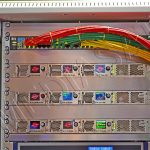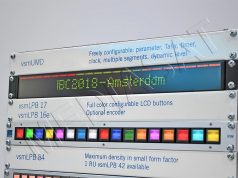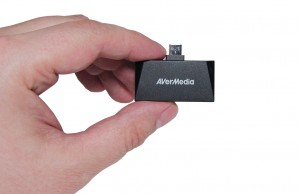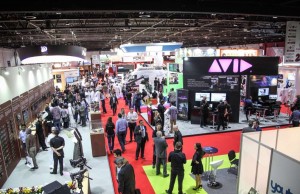End. Read the beginning in the article IBC 2017: 50 years of innovations…
Solutions for testing, monitoring and parameter measurement
With expanding number of devices in the market, the vital task for hardware manufacturers is testing. Here, we mention the solution of Sitest (Czech Republic): the best option when you at once need to test a lot (over hundreds) of devices (Smart TV, Xbox, etc.) and get a report on their compatibility. The solution runs various platforms, including Android TV, Fire TV, Freeview Play, Xbox One, among others. You just create own tests and run without any programming skills. There are available various subscription options, i.e. from 0 to 900 euros.
The company also announced a multipurpose Candybox control panel for simultaneous monitoring of multiple TV receivers (up to 40). There are modifications for a smaller number of tested devices (8/16/24/32).
New equipment RSC500 for monitoring DVB-T/T2 networks was presented by Gsertel (Spain, former unit of Televes Corporation). The solution provides radio frequency control within a 20 MHz spectrum in real time (including BER, MER parameters). It supports USB, Ethernet, and HTML5.
Promax Electronics announced its analyzer RangerNeo 4 (DVB-T/T2/C/C2/S/S2, coming in early 2018).
Narda Safety Test Solutions presented its prototype analyzer with the antenna SigmaShark 331Q (9 KHz – 8 GHz, coming in January 2018).
Monitors for broadcasters
TVLogic presented its model LEM-550R (coming in early 2018), a HDR monitor designed on OLED panel (55˝) with viewing angle of 179 degrees, supporting UHD (3840×2160), 12G-SDI/6G/3G, HDMI 2.0. The firmware is updated via USB. By the way, the manufacturer does not yet specify the power consumption, obviously, anticipating the presentation of a super energy efficient solution.
JVC presented several lines of monitors of DT-U and DT-G families. Both families have a wave monitoring option with a vector-format signal display in the form of a histogram, as well as remote monitoring via IP. The DT-U family is 4K monitors DT-U28E (28˝ UHD) and DT-U31E (31˝, 4K-panel 4096×2160). The models of this line support 4HD-HDI, 12G/6G/3G/SDI/HD-SDI, HDMI. The monitor calibration software is integrated into the line. The firmware is updated via USB. The line is coming in late winter 2018. Another DT-G family includes models: DT-G17E (17˝), DT-G21E (21˝), DT-G24E (24˝), DT-G27E (27˝). The line uses an 8-bit IPS matrix with 12-bit signal processing logic. It supports 3G/SDI, HDMI 2.0, 4K downscaling. There is a built-in monitor calibration. Models are coming in late 2017.
Solutions for content protection
Within the exhibition, Conax (incorporated into the Kudelski Group, headquartered in Norway, and providing secure content for 425 operators in 85 countries), the leader in providing complete security for digital television and entertainment content delivered via broadcasting broadband networks and plug-in devices, presented several new solutions. Among them, there is the new cardless client Conax Prime Access, aimed at protecting access to premium content 4K/UHD (including HDR) in hybrid TV set-top boxes, announced at the press conference. According to the company, the solution will allow operators to increase their revenue per subscriber (ARPU).
The cardless security client Conax Prime Access is designed with a set of functions for hybrid set-top boxes for the networks of satellite, cable and terrestrial operators. It is optimized for high bandwidth and provides high-level security for unidirectional networks without a mandatory reverse channel. This client is especially focused on operators who are eager to provide high-quality HD and 4K/UHD content, including HDR, Live-TV, subscription, EMM Pull, PVR, as well as to “track” legal content. It includes PVR sharing, the ability to transfer recorded content from one set-top box to another under the operator’s control.
Among the advantages of Conax Prime Access for Pay-TV operators, we mention just few ones. The solution is designed for broadcast content and provides access to premium content. At the same time, the user engagement goes up and the subscriber churn goes down. It provides a high-level security when broadcasting content via set-top boxes, and facilitates Pay-TV operations. The solution is focused on the special preferences of operators.
What is the contrast to the basic version Conax Core Access? From the operator’s viewpoint, Conax Prime Access provides 4K/UHD support for MovieLabs content and other premium content, including the sports one. It secures content delivery to hybrid set-top boxes with advanced middleware solutions available through third-party applications.
From the partner’s viewpoint, Conax Prime Access will require a TEE-based chipset in order to be integrated into a set-top box. The cardless security client Conax Prime Access (which is built into Lynx) provides secure control over the content decryption process, in combination with a secure media player (SMP) and copyright control mechanisms for premium content. This facilitates the implementation of the conditional access system for STB-providers, as well as interface for middleware-software partner developers.
For the time being, Conax Prime Access is supported by over 200 chipsets (including products of Broadcom, MStar, ALi). In addition, a large part of chipsets is still under testing.
Conax Prime Access with pre-integrated Conax Lynx provides a single interface for middleware solutions. Conax Lynx provides access to third-party OTT applications and services. There are already available in the market the following solutions: Android TV, Linux, Open TV, RDK and others. The interface for Lynx is easily adaptable for any middleware solution, whether it is Android TV or Linux-STB. It all depends on customer preferences. Conax also plans to provide access to Conax Prime Access through the Farncombe security audit by Cartesian.
Expanding its portfolio of Conax Cardless solutions for premium content, we mention Conax Arena, among Conax’s innovative solutions, a new modular multi-screen service with an excellent combination of security and flexibility, designed for European Pay-TV operators. At the press conference, the company presented its Conax Media Service “all in one” platform for managing, storing and distributing digital content, as well as providing legal content security and monitoring. There were presented reliable and secure hybrid set-top boxes with advanced intermediate solutions from partners, including ADB and Mirada.
During the presentation, there were examined Media Asset Management Services (MAM) through Conax Media Service: a highly automated “all-in-one” platform that offers metadata and digital content file management, transcoding, storage, distribution and post-production services. As well as a fully secure platform for legal content monitoring, used along with NexGuard to meet the high security requirements of a production studio for premium content in 4K format.
Among the main advantages of Conax Arena, let us mention its flexibility for cameramen who can choose partners for integration into one single solution. With the growing demand of consumers to watch content on any device and at any time, streaming services become a de-facto standard of modern television for many people. Thanks to Conax Arena, operators can provide their services on traditional STBs, phones and tablets, in addition to applications on Roku, FireTV, game consoles, etc.
Thanks to the new multi-screen solution Conax Arena, Pay-TV operators will be able to run their full-screen E2E solutions adapted to the domestic market, and at once use the functions of pre-integrated services. Conax Arena consists of several components: Conax Arena, Conax CMS (cloud-based content management system with an option to manage, publish and distribute interactive video services and VoD services), pre-integrated Middleware software (Accedo, Beenius, OpenTV, Tivo).
Another company’s innovation is its Conax Lynx, which should interest not only operators, but also manufacturers of set-top boxes and vendors. This is a standalone solution based on TEE technology (Trusted Execution Environment), designed to meet the requirements for enhanced content protection (ECP), according to the requirements of MovieLabs on hybrid TV set-top boxes and to facilitate the integration of conditional access systems for software middleware providers and set-top box manufacturers. It is supplied as a Software Development Kit (SDK). Conax Lynx is available as an add-on for Conax smart cards. For customers without security cards, Lynx is pre-integrated into Conax Prime Access.
Conax Lynx cuts costs of middleware software partners and provides access to the premium 4K/UHD content for operators.
Prime Access is pre-integrated into Lynx, using architecture protection that allows Pay-TV operators to easily integrate their own or third-party OTT services into their solutions.
The plug-in set-top boxes are open to third-party applications, what causes an increased threat to piracy. In addition, Pay-TV operators must comply with more rigid MovieLabs’ rules for ECP specifications in order to eliminate problems of redistributing pirated content and content on the connected devices. Operators can securely implement OTT services in the same kit of applications, without interfering with DVB content. Thus, operators will be able to focus on providing extra functions on end-user devices, which will reduce subscriber churn and increase operators’ ARPU.
Middleware providers who plan to integrate Conax security solutions on multiple set-top boxes can use a standard set of API interfaces. Conax Lynx solution in combination with Smart Card or a cardless client provides operators with the flexibility in opting for the most ideal solution to deliver their content to end users.
In view of fast growing Internet piracy and copyright holders’ crackdown on this phenomenon, there is of interest a solution of the exhibition’s newcomer Geocomply Global (Canada). The GeoGuard solution is aimed at antipiracy on the Internet. According to the company, 50% of households have streaming devices. Some 21% of users make use of VPN for illegal access to content, and 60% do it regularly. The current situation allows users not only to receive content anytime, anywhere and on any device, but also at the price they want, and not the one offered by copyright holders. In fact, 30% of Internet users are active and regular in using VPN and DNS proxy servers, what boosts the piracy. The copyright holders’ annual losses from piracy amount to some USD 18.5 billion. By the way, 30% of English football fans are even up to break contracts with domestic operators in favor of foreign Internet broadcasting. According to some data, 24% of the bandwidth of all communication channels is pretty used for online piracy. 70% of people aged 18-29 downloaded illegal content from the Internet over the last year. The GeoGuard solution takes a number of steps to aggregate, filter, analyze content online and then report on it. This solution makes it possible to block 100 thousand new “free-content” sharing “sites” monthly. Someone in Ukraine watches content from another continent, but should not? This is a common task for GeoGuard. However, almost all solutions of this kind limit their power to sending their reports to the copyright holders, and not to real blocking of sites.
The anti-piracy solution, presented by the European company TMG, provides a 24-hour automated monitoring of broadcasted content in order to verify its legality. The solution analyzes content for the “bookmarks” of the copyright holders (fingerprinting), and in case of their lack notifies owners about illegal broadcasts. The minimum duration of the video to check is 2 seconds.
Equally interesting and announced at the exhibition was the cloud service KeYOS by BuyDRM (USA), provider of digital right control services. The solution is designed to protect content, both broadcasted online, and available via VoD.
According to the latest RTL/Ad Connect TV Key Facts, the main consumers of video in Europe are mobile devices. The total daily viewing of online videos was 1 h 4 min in 2016, which is 51 minutes higher than in 2012. At that, 45 minutes refers to mobile devices (+41 minutes against 2012), and 19 minutes are not desktops or mobile devices (+10 minutes against 2012).
According to DataXis, as of the second quarter of 2017, the total number of Pay-TV subscribers amounted to 1.05 billion (1 billion was risen beyond in late 2016). From Q2 2016 to Q2 2017, the number of Pay-TV subscribers grew by 60 million. The largest increase was observed among IPTV subscribers and linear OTT (24% and 44, respectively). India and China account for 48% of Pay-TV content. At the same time, cable operators go on losing their subscribers.
Solutions for broadcasters and operators
Mobile operators should be interested in AIR3246 by Ericsson, aimed at increasing the capacity of actual LTE networks and expanding 5G subscriber base. The solution supports both 4G/LTE, and 5G. Thanks to the company’s own technology 5G NR Radio for Frequency Division Duplex (FDD), the network capacity can be triplicated, which results in its fivefold improved performance for end users. In addition, Ericsson announced its solution MediaFist Content Processing, the first software multi-function platform, which is ideal choice for distributing UHDTV and HD HEVC content, with optimal picture quality (4:2:0/4:2:2) and minimum delay.
There are equally interesting other solutions of the company like the cost-efficient HD-scrambler-multiplexer, with supports up to 24 HD or 72 SD (transcoding) or up to 16 HD or 48 SD (encoding) channels, as well as the hardware decoder RX8200 with built-in digital content protection technology (watermarking) and integrated technology NexGuard.
Another solution is the AVP2000 encoder and MFCP decoder for UHDTV with low delay.
Rohde & Schwarz presented its Venice, a platform that should be of interest to production studios and companies demanding for a reliable and fast solution for 24-hour content broadcasting. Here, the company applied its own technology VSA (Virtual Storage Access), which provided sustainable operation in 365/24/7 mode. The video server with a disk array supports bidirectional broadcasting of one UHD channel (p60) and up to 4 HD ones (p60). Data backup provided (if one channel does not work, the other emergency one is used). 1 unit supports a data rate of 3 Gbps. The solution supports SDI/IP and can be equipped with an internal disk array RAID of up to 14 TB. There is also of interest the air-cooled TLU9 transmitter (capacity from 5 to 200 kW, HTML5, DVB-T/T2/T2lite, etc.).
The NHK’s stand (Japan) in the Future Zone traditionally crowded together the visitors, who were interested in ultrahigh resolution video. (8K Super Hi-Vision). This time, the company exhibited its new Sony camera with three CMOS sensors, as well as the features of 8K TICO codec for 8K content. After all, the Summer Olympics 2020 in Tokyo are forthcoming.
The TICO codec, designed by intoPIX S.A., allows transmitting 8K signal with a single 12G-SDI cable with very low delay. The real bitrate of uncompressed 8K video is 48 Gbps (59.94 Hz, 10 bits, 4:2:2).
Sistemas Audiovisuales Italsis (TM Itelsis, Spain) presented its compact 600-Watt transmitter that facilitates shifting between DVB-T/H, DVB-T2 and ISDB-Tb.
By the way, despite the solution’s simultaneous focus on several continents with different broadcasting standards, the same modulators are used for both Europe, and the United States. The solution is characterized by its low power consumption. There is remote monitoring via Web-interface and built-in GPS. It supports 3G/Wi-Fi.
GatesAir also presented two transmitters: Maxiva UAXTE/VAXTE with 150 watts and 1000 watts of power.
There were presented equally interesting solutions of the German company Astro Strobel Kommunikationssysteme (ASTRO brand, Germany), known to European and domestic cable operators due to a wide range of IP to RF products (PAL/QAM/FM) for building networks of remote head-end stations delivering content via backhaul IP network in the format of compressed MPEG video (MPEG over IP).
Until recently, the most popular products in this line were the ones for high-quality analog cable broadcasting (ASTRO U116, U118, U118x), deployed in the networks of the largest operators: in Germany (Deutsche Telekom and Kabel Deutschland), in Switzerland (Swiss Telecom), in Russia (Rostelecom), etc.
The products provide reliable services supporting various options for automatic backup, for example, in case of an accident with traffic channels, the loss of some input video services, or hardware failure. Despite the main “defect” of this equipment, i.e. not the lowest price on the market (the products are designed and manufactured directly in Germany near Cologne), the company eliminated the fault by completing its IP to PAL product line with a high-quality 24-channel cable modulator U224 in RU 1 case at an affordable price. The reasonable price was set at the expense of giving up generality, i.e. the U224 does not support the solution of simultaneous housing analog cable modulators, digital QAM and FM-radio modulators. The solution slightly reduced the output parameters to more relevant ones for medium-sized cable networks. At that, channel-to-channel out-of-band emissions are provided at 60 dB below the video-carrier signal.
Unlike other inexpensive commercially available IP to PAL solutions, the U224 offers functions for a guaranteed reliable operation of head-end station, including network error correction in the IP network (ProMPEG FEC); RTP protocol with an option to compensate the jitter and detect a failure in the sequence of packet interleaving. At the same time, despite its low price, the U224 cable modulator retained the company’s video correction function implemented in the top devices U116/U118x. As well as its “older brothers” in the family, the U224 provides the correction of visual video artifacts separately at brightness and chroma levels. The operator can systematically control brightness filtering band and the precise “per-pixel” adjustment of a provisional offset of the color difference data with respect to the brightness ones. Let us remark that among the commercial IP to PAL/SECAM modulators, just only ASTRO Company offers such a unique reasonably priced function for correcting video artifacts.
U224 has 3 independent modules, any of which can be quickly replaced with the backup one in case of any failure. Each module has an SD memory card with saved configuration, which allows swiftly transferring all the settings of the faulty module to the backup one. The U224 has 3 groups of video input ports (3x2x 1000 BaseT) and 3 groups of control ports (3x2x 100BaseT), which provide backup schemes in case of broken IP-links for both video data and control. In the event of a partial loss of input IP-multicast groups, there is provided automatic backup.
The U224 is equipped with a dual power supply for 220V and 48V (the latter is cheaper) with automatic backup and hot swapping; it has low power consumption (under 130 W), supports working with HD content due to converting it to SD (downscaling). There is a support for Teletext, VPS, WSS, Teletext- and DVB subtitles.
Newtec presented several solutions, including its high-performance bidirectional modems MDM2210 (DVB-S/S2X) and MDM3310 (DVB-S2X).
The MDM2210 solution is part of the terminal solution operating in the Ku/Ka bands (0.75-meter to 1.2-meter dishes are used for the Ku band and 0.7-meter and 1-meter ones for the Ka band). The second model MDM3310 is a bidirectional high-performance modem for VoIP and Internet services.
Let us recall that thanks to the DVB-S2X technology, the transfer efficiency grows at 22%. 36 MHz transponder, conventionally hosts only 3-4 UHDTV channels (or 12 HD channels). However, channel bonding allows for “squeezing” 11 instead of 9 UHDTV channels, using the same transponder capacities. Thus, the volume and the amount of delivered content increase.
Explorer (Japan) announced its EHU-2400E/EHU-3400D – 4K H.265/HEVC encoder-decoder supporting 12G/3G/HD/SD-SDI.
NewTek presented several solutions like IP-camera NDI-PTZ1, wireless HDMI/SDI-NDI converter NewTek Connect Spark, as well as IP graphics server NVG1.
Matrox presented its Extio 3 IP KVM extender with a very low bitrate and support for 4Kp60 (4:4:4) or up to 4 video signals 1080p60 (4:4:4), USB 2.0, Ethernet 1Gbps.
AJA Video Systems presented several engineering solutions. Among them, there is a one-unit rack-mount universal converter/synchronizer for HDR conversion in real time and cross-conversions for 4K/2K/HD (including upscaling and downscaling), 12GDA amplifier (12G/HD/SD-SDI), 12GM multiplexer (12G-SDI), as well as a family of converters FiDO-T-12G, FiDO-R-12G, FiDO-2T-12G, FiDO-2R-12G, FiDO-TR-12G.
Apantac presented several variants of multiviewers Si-16-ST-2022-6, Di-16-16 HDMI, MI-8-12G, T#, with support for 2022-6 and 12G, as well as its switch Mini DE-4-UHD-K (UHD KVM).
The visitors’ interest was captured by the electric all-terrain vehicle Ski-Doo by HS-DynaX5 Cam Solution (Germany), presented outdoors, which is an attractive offer for broadcasters and cinematographers. It was used a five-axle camera with stabilization, as well as VISLINK for signal transmission. The ATV is able to drive up to 40 km, and requires 2 hours for recharging.
VUALTO announced its Vualto Control Hub, a software platform for video online delivery (VoD) to any device that automates the process of “distributing” video from live broadcasts to VoD, as well as the digital rights management (DRM), etc.
Among the announced solutions, let us mention the OTT platform YUPPTV with options of multiscreen and VOD streaming. For the time being, the solution provides broadcasting of 400 channels and offers detailed metrics in real time. Another recently announced product Freedocast by YUPPTV is designed for broadcasters and operators. There is an option to work even in low-bandwidth networks with adaptive bitrate. You can run online broadcasting at once on multiple platforms. Its operation requires Ethernet 10/100 Mbps or dual-band Wi-Fi (2.4/5 GHz). The battery provides a broadcast duration of up to 2.5 hours. It supports HDMI. To broadcast, it is enough to connect a camera to the Fredocast Pro device and go on the air via the suggested platform.
The growing consumer interest in retro is also proved by the exhibited developments. Thus, Digital Film Technology (Germany) presented its WetGate solution for scanning photographic films and upscaling up to 4.5K. The scanning runs in a solution with alcohol content, which provides for removing dust, small scuffs and damages. After scanning, the film is dried.
Broadcast and post-production studios should be interested in the 2,5˝ SATA SSD disk 3MV2-P (2 TB), announced by Innodisk (Taiwan).
The solution for radio stations Skype TX, announced at NAB by Broadcast Bionics was presented in its final version, the company is about to release a similar product for TV stations in early 2018.
Dishes
Funke Digital TV (Holland), celebrating its 60th anniversary, presented a new antenna supporting own 4G LTE INERT technology.
The decision is coming by this year-end. Since the issues with frequencies are not settled down in some countries, two options are offered for two bands: 470-790 MHz and 470-694 MHz. There is applied a low-noise amplifier, and the device itself has a low power consumption. The gain power is 32 dB, and the manufacturer guarantees its antenna efficiency at a distance of up to 40 km from the transmitting center.
Actia Group (France) presented several solutions. This is a lightweight TravelSat DEKA065, a satellite terminal for Ka-band weighing up to 32 kg with a fast setup time (less than 15 minutes). The main application is government secure communications (via IP), military and rapid response units. The security level is IP65. One person can transport and configure this device. A carbon antenna with a diameter of 65 cm with manual configuration provides a download rate of up to 1 Mbps. The standalone mode with external battery is up to 3 hours. The standard delivery includes iDirect modem e150 (DVB-S2 with downstream) and A-TDMA (upstream).
Another new product coming in November – DEKA/OTM, is a bidirectional antenna system MobileSat for transmitting video/voice/data traffic on the go in the Ka-band (installed on both civil transport and military equipment). It is functional at speeds of up to 150 km/h. The power consumption is 25 W (peak consumption is 70 W).
Its new antenna was presented by SVEC Global TV for the Ku band (12.25-12.75 GHz) (TM SVEC, China).
Technologies and interesting solutions
The assimilation of modern information technologies affects many areas, including medicine. This is the very robotics activity of the TOIA project by Generic Robotics (Great Britain).
There was exhibited a dentist simulator that should learn how to inject and not to harm any patient. The system blocks any attempts to use a “sharp object” outside the patient’s mouth. The solution attracted many visitors to appreciate the above simulator at the expo-stand.
In the Future Zone, there was presented a software project AVEROS, a joint development of Cube-Tec, Joanneum Research Digital, HS-Art Digital and Sound and Vision. The prototype solution is designed for inexperienced users who are not advanced in the nuances of improving video from older films, but desire to get a video “without noise and dust”, stabilized (without “camera shakes”), without blinking, etc. The solution works in the cloud, and the final release is coming in late April 2018.
Conclusion
In the near future, we anticipate the ongoing assimilation of HDR, HFR, UHD, and Wi-Fi, VR and other technologies in various devices, taking into account their further miniaturization and energy efficiency.
If we peep into the near future, then in 2020, NHK is about to start 8K broadcasts from the Summer Olympics in Tokyo. By 2021, according to Cisco, 82% of Internet traffic will be video, while the total traffic will exceed 3x10e21 bytes.
By 2066, the world population will grow up to 10.5 billion, and some of them (about 50 million) will migrate to Mars. The planet will be “covered” with 5G, and consumers will get available low-cost VR camera with a resolution of 16K. In the same year, there will be more than 10 billion TV channels in the world, an average of one per inhabitant. And it is quite possible that some of the forecasts would come true even before the expected time, and as for the technologies to be actively used everywhere, we can see them at the next IBC 2018.


































































